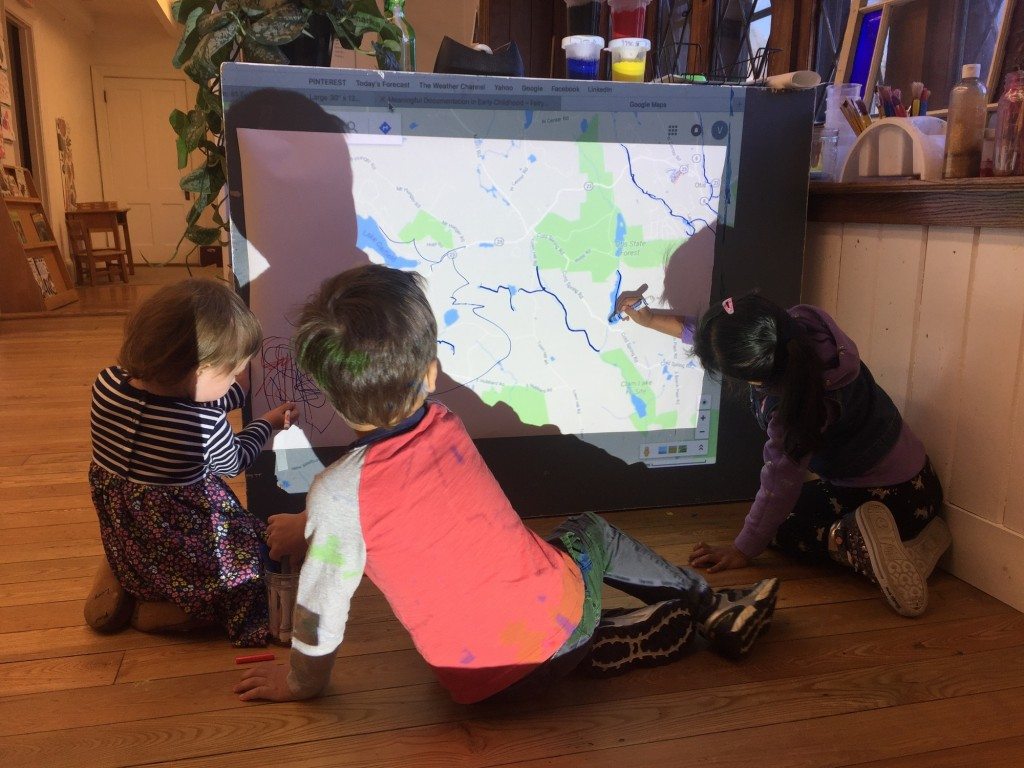At the heart of the Reggio Emilia philosophy is an emergent curriculum which builds on the interests of the children. The curriculum is not pre-planned by the teachers. It is flexible and originates from the children’s thoughts, ideas, and curiosities. We observe the children carefully, watching them play, discovering their interests, and listening to them talk. Topics for study are captured from these observations.
“Where’s Julia?”
Julia Kreilkamp, Beginner 2s Lead Teacher
Very quickly in our two-year-old classroom this September, we noticed that the chi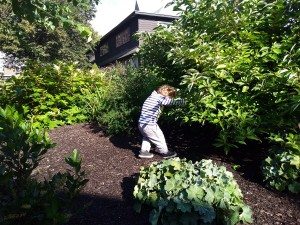 ldren loved to find places to hide. In a walk around campus during the first week of school, the children turned a big bush into a hiding place; they found apples on the ground and started to hide them in a hole in the apple tree; they draped a silk scarf over their heads to hide from us.
ldren loved to find places to hide. In a walk around campus during the first week of school, the children turned a big bush into a hiding place; they found apples on the ground and started to hide them in a hole in the apple tree; they draped a silk scarf over their heads to hide from us.
We noticed their love of hiding places and began to invite them to explore other ways of hiding, and also ways they could hide objects. For example, we placed a large cardboard box in the room one morning. We hid shells in the sandbox. Another day, we hid small animals under larger shells in the sand. We draped the scarves over the balls in the gym.
The children started to find new ways to hide objects and to hide themselves: animals hid in the stacking boxes or in the play kitchen; the children crawled under a runner rug to hide.
While the children are fully engaged with the “hiding,” new opportunities for language development arise. We use prepositions: in, on, around, under, over, beside. We ask questions that the children can’t wait to answer: “WHO is in the box?” “WHAT is in under the shell?” “WHERE is the ball?”
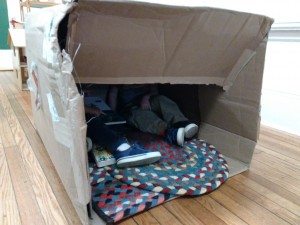 As well, the hiding provides a multitude of opportunities for social interaction. The children snuggled up together to hide in the box. They delighted in “finding” a new friend under the scarf. Soon they were in cahoots together hiding in the rhododendron bushes outside. They seemed to learn one another’s names more quickly because of the hiding project. Our classroom community grew stronger and richer because of our shared experience with hiding places.
As well, the hiding provides a multitude of opportunities for social interaction. The children snuggled up together to hide in the box. They delighted in “finding” a new friend under the scarf. Soon they were in cahoots together hiding in the rhododendron bushes outside. They seemed to learn one another’s names more quickly because of the hiding project. Our classroom community grew stronger and richer because of our shared experience with hiding places.
“X Marks the Spot”
Vicky Sideropolous, Beginner 3s and PreK Lead Teacher
Recently in the 3s/4s Preschool class, there has been a growing interest in drawing treasure maps. We took that interest and began to explore the possibilities. We started by putting out maps and letting the children look more closely at them, draw on them, discuss them. We talked about why maps are important, why we need them, and what they are for. Ms. Junod and I have been offering several possible directions for this study to take, materials to facilitate this, and opportunities to help the children think deeper.
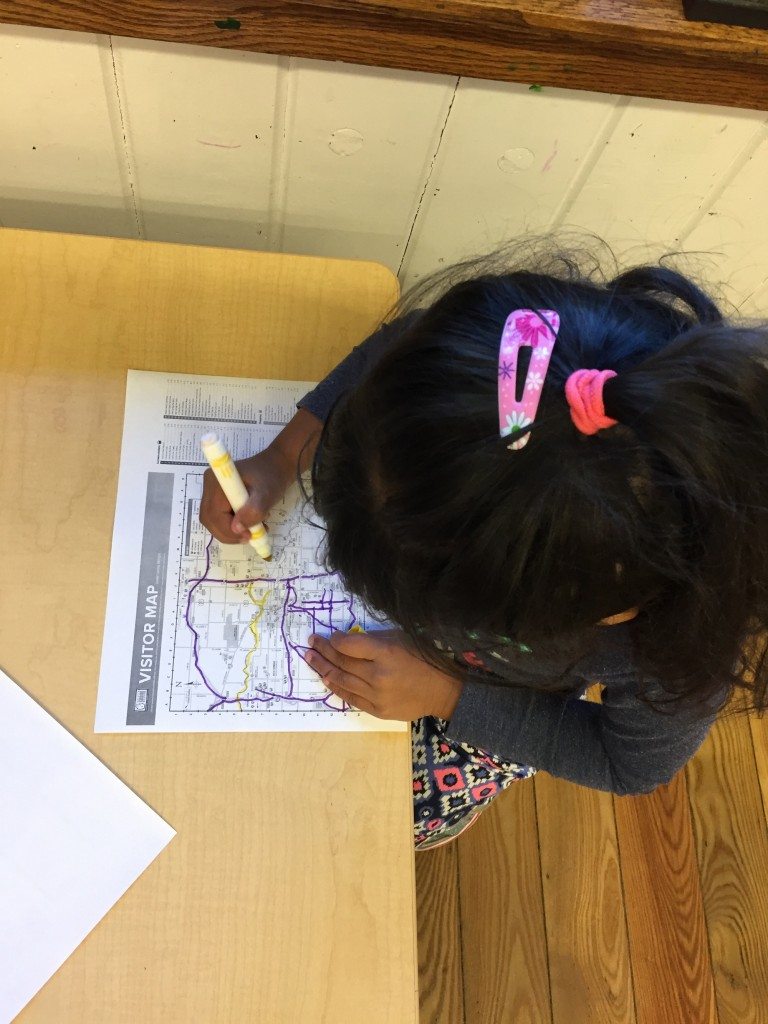
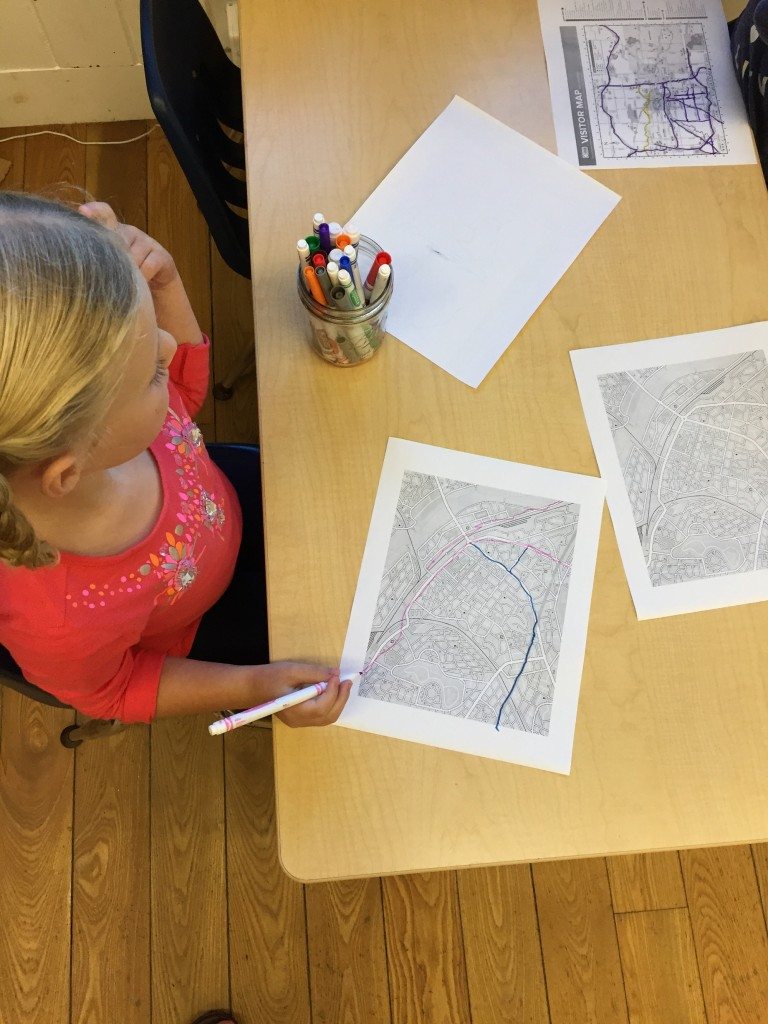 In the beginning, the students were given an invitation to explore maps. Blank maps were put on the table with markers and magnifying glasses. Students decided that they would trace the roads. Some added houses, some drew in schools. There were toy shops and airports, trees and lakes. Their maps were coming alive! In a meeting, we discussed why we have maps and what maps tell us. The children said that “maps show water where it is blue,” “they can tell you how to get to a toy store,” “you can see airports.” Through their play with maps, the children are working on spatial relationships skills, as well as language specific to maps (such as directions and geographic terms) and general language in our lively, interactive discussions.
In the beginning, the students were given an invitation to explore maps. Blank maps were put on the table with markers and magnifying glasses. Students decided that they would trace the roads. Some added houses, some drew in schools. There were toy shops and airports, trees and lakes. Their maps were coming alive! In a meeting, we discussed why we have maps and what maps tell us. The children said that “maps show water where it is blue,” “they can tell you how to get to a toy store,” “you can see airports.” Through their play with maps, the children are working on spatial relationships skills, as well as language specific to maps (such as directions and geographic terms) and general language in our lively, interactive discussions.
While studyin g maps, we have also been finding ways for the class to build community and learn how to work together as a team. A week into our Map Study, we set up a treasure hunt, starting with a map of the school and a big “X” marking “the spot.” The students had to figure out how to find the “X.” Ms. J and I guided the class in ways to collaborate, including how to problem solve as a group and take how to turns. Finally, after a lot of discussion, the class worked together, followed the maps, and successfully found all three “X’s”!
g maps, we have also been finding ways for the class to build community and learn how to work together as a team. A week into our Map Study, we set up a treasure hunt, starting with a map of the school and a big “X” marking “the spot.” The students had to figure out how to find the “X.” Ms. J and I guided the class in ways to collaborate, including how to problem solve as a group and take how to turns. Finally, after a lot of discussion, the class worked together, followed the maps, and successfully found all three “X’s”!
Every year we explore new topics, every year there are new and exciting things to learn. Stay tuned!


